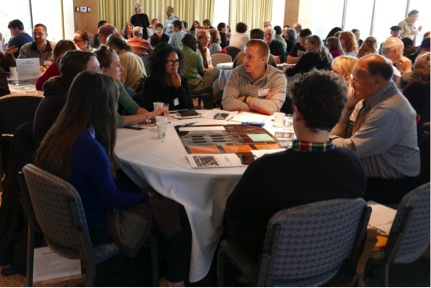This is a guest post from David Sittenfeld, Manager, Forums at the Museum of Science, Boston.
FIREFLIES, HEALTHIER CITIES, AND POLICY INPUT: CITIZEN PARTICIPATION IN SCIENCE AT THE MUSEUM OF SCIENCE IN BOSTON

At the Museum of Science in Boston, we’ve been exploring three flavors of citizen science over the last half-decade or so. We started with fireflies and have added participatory efforts around urban environmental health assessment and participatory policy formulation. We’re excited about the way that citizen science has transformed the landscape for science and are looking forward to what’s next!
The nationally recognized Firefly Watch project, created by Museum educators Don Salvatore and Maureen McConnell in 2008 in collaboration with researchers from Tufts University and Fitchburg State College, allows volunteers to submit firefly flash data collected from their own backyards. The data help the project researchers to explore the reasons for observed changes in firefly populations.
Citizen scientists who sign up for the project spend ten minutes on a single evening each week counting the number of flashes that they see, and then upload their data to the project database. The project website includes a virtual habitat that helps data collectors get familiar with the flash patterns, as well as a discussion board and a data visualization portal. A smartphone app allows volunteers to view data from other contributors, double-check on flash patterns, and read about emerging firefly research. Learning about firefly natural history is an important aspect of the project.

Building upon the success of the Firefly Watch, the Museum has begun engaging youth in other kinds of citizen science projects. A multi-year project called “Planning For Healthier Cities” engages teens in a series of participatory environmental health assessments around issues such as urban heat island effect, air quality, and water quality. Project partners include the City of Cambridge, the Somerville Transportation Equity Partnership, Northeastern University, MIT, Harvard University, and the Charles River Watershed Association. Working in collaboration with a group of expert mentors and community stakeholders, youth interns and volunteers formulate research questions, choose instruments and data collection protocols, and gather data for a number of environmental health issues such as ultrafine particle pollution, indicators for harmful cyanobacterial blooms in the Charles River, and urban summer temperatures.

After collecting their datasets, the students work closely with Museum project staff to visualize and model their data using geospatial mapping and statistical software, and then create “decision-making dashboards” that are used in a community forum that occurs at the culmination of the experience. In this concluding event, the students present their findings to a group of peers, local residents, and stakeholders, and then ask the participants to consider and recommend policy strategies for making urban spaces healthier places to live and work in light of the students’ work. The interns create discussion scenarios that invite the attendees of the forum to think about the issues of air quality, water quality, and urban geomorphology from a variety of policy perspectives. In the iteration from last summer, the interns and project team created this website (“Planning for Healthy Cities”) to present and share their results.



Finally, the Museum also taps into the power of citizen participation in a different way, through its Forum program. The Museum has held over 50 citizen forums in the last five years around topics such as genetically modified mosquitoes to children and computer use, nanotechnology, and adapting to sea level rise. In these events, participants consider and make decisions about socio-scientific issues that science informs, but cannot answer on its own.
Now, with the help of our partners from a network called Expert and Citizen Assessment of Science and Technology (ECAST), we’re trying to increase our impact by connecting to formal policymaking. The Museum was a host site for two global deliberations called World Wide Views on Global Warming in 2009 and World Wide Views on Biodiversity in 2012 to inform United Nations delegates.
Most recently, we worked with partners from SciStarter, Arizona State University, and others from ECAST, as a client for NASA, to plan and host two deliberations to inform NASA’s Asteroid Initiative. Approximately 100 everyday citizens at two science centers in the US learned about, considered, and made policy recommendations for planetary defense strategies, the NASA’s proposed Asteroid Redirect Mission, and the proposed Proving Ground framework for prioritizing deep-space exploration. Sign up now to get involved in the final stage of NASA’s Asteroid Initiative: A Citizen Forum. Participant recommendations are in the process being of analyzed and sent along to NASA.
When we started thinking about getting into the citizen science sphere, we didn’t really know where it would lead. But we’re really engaged by the steps we’ve taken so far and excited to think about where else these kinds of efforts can take us.


